(Translations: Español)
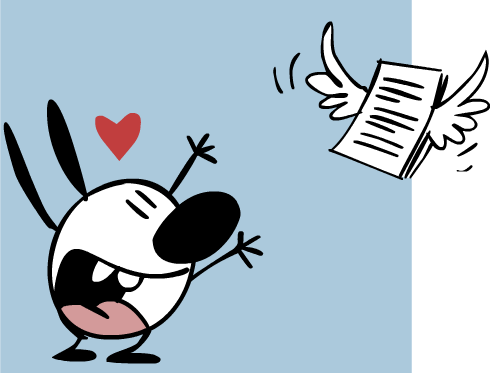
I. Theory:
Why should you Free your work? To make it as easy as possible for people to share your work — as easy as possible for your work to reach eyeballs and ears and minds — to reach an audience.
And to make it as easy as possible for audience support — including money — to reach you.
Forms of audience support include:
- Money – Audiences want to support artists they like. A “Donate” button gives them an easy mechanism to do so. Audiences buy merchandise from artists they like for the same reason. Give them a “Reason to Buy” and they will.
- Work – some fans can make web sites, sell merchandise at concerts, help with promotions, etc. If you need help, ask your audience first. No one is more motivated to help you than your true fans.
- Promotions – word of mouth recommendations are the most effective form of promotion, and audiences do this without coercion if they like a work.
- Distribution – often called “piracy,” this is an extremely valuable service. Distribution without audience assistance is expensive: imagine if you had to pay for every copy of your work (as in paying for a print run of paper books, or plastic discs), and then store and distribute them to every potential audient. Want 1,000 people to hear your song? Imagine if you had to pay at least $1,000 up front for even the chance – not including costs of storage and shipping. You can then of course charge them for the privilege of hearing your song, by selling them discs – but this cost barrier makes it even less likely they’ll want to hear it. When the audience distributes your work for you, they bear the costs of making and sharing copies, not you. Audience Distribution costs you nothing.
- Archiving – the cost of privately archiving your own work is very high; fans do it for free. The Freer the work is, the more robust its archives will be, especially as technologies and formats change. CDs and DVDs may become obsolete, but fans migrate works from one format to the next, ensuring they’re always accessible and up to date. Example: copy-restricted films are distintegrating in cans. Digitizing them is expensive; digitizing them without permission is too risky to invest in. Without audience help, these costs must be borne exclusively by the “copyright holder.” Digital archive formats are notoriously unstable; many hard drives from even ten years ago are incompatible with today’s technology. Video codecs change rapidly, and no one knows which codecs will remain in use, and which will become obsolete. A private rightsholder must continually research what new formats are evolving, and make sure to migrate their archives. They are still likely to miss some format changes; it’s very hard for a single entity to stay abreast of every diverse technological innovation. Analog formats are safer, as they don’t change as rapidly, but 35mm film archiving is extraordinarily expensive. The negative must be transferred to archival films, then stored in a secure facility. If anything happens to that facility, or rents aren’t paid, the archive is lost. In contrast, Free Culture opens the possibility of the most robust, decentralized, up-to-date archiving system ever: the audience and all their devices.
Copy restrictions place a barrier between you, the artist, and most forms of support. By removing the barriers of copyright, you make it possible to receive money and other kinds of support from your audience, both directly and through distributors, thereby increasing your chances of success.
II: Practice: How To Free Your Work
- Get your own web site.
There are countless ways to make a web site, from hiring professional designers and technologists, to getting a free blog. Assuming you’re broke and have no tech skills, here’s the easiest way to do the latter:
- Sign up for a WordPress blog here. It’s free and easy.
- Follow instructions from there
That’s it. Your own web site, free, with loads of templates to choose from and lots of help from wordpress. That’s all you need! You can certainly get more advanced from there, but that will require more skills, time, and/or money. A free WordPress blog is more than enough to get started.
- Get PayPal, Flattr accounts. Place “donate” and “Flattr” buttons on web site.
To receive money online, you will need a money-receiving account. Here are some you can sign up for – click the link(s) and follow instructions.
PayPal (recommended) – easiest to use, and allows anyone to accept donations.
Amazon Payments – a little more comlplicated. This is also the payment system used by Kickstarter.com
Google Checkout – only allows registered 501(c)(3) or 501(c)(6) tax-exempt organizations to receive donations
Once you have a PayPal account, you can generate a donate button for your web site.
In addition to PayPal, you can also get a Flattr account. Flattr combines a donations system with social networking to create a hybrid that’s both fun and hard to explain. Visit Flattr.com for more information.
- Choose a Free License.
A Free License is legal language that sits on top of copyright. In our current copyright regime, everything is copyrighted whether you want it to be or not. What I’m writing here is copyrighted, even though I don’t want it to be. There is currently no way to “opt out” of copyright. All I can do is attach a “Free License” to the work, that grants users some of the fredoms that copyright automatically takes away.
A Free License guarantees the Four Freedoms of Free Culture:
1. The freedom to view, hear, read, or otherwise attend to the Work;
2. The freedom to study, analyze, and dissect copies of the Work, and adapt it to your needs;
3. The freedom to redistribute copies so you can help your neighbor;
4. The freedom to improve the Work, and release your improvements to the public, so that the whole community benefitsCreative Commons is the most famous brand of Free licenses, however most Creative Commons licenses are not Free! Just because a license is branded Creative Commons does not mean it’s free. In fact most Creative Commons licenses have restrictions that are incompatible with Free Culture.
The 3 Free licenses Creative Commons offers are:
If you see the letters -NC or -ND anywhere in a Creative Commons license, it is not a Free license. Be careful – use only one of the above Creative Commons licenses, otherwise your work will not be Free and you may alienate those fans who could help you the most.
Other Free licenses for cultural works include the Free Art license and the WTFPL.
Because all licenses ride on top of copyright, they can be seen as validating or extending the reach of Copyright law. For those who are totally fed up with existing laws and the interference of lawyers in the cultural sphere, a “non-license” may be preferable. Non-licenses are not licenses, they are statements of intention: that the artist wants their work to be copied. They don’t ride on top of any existing laws, and attempt to avoid law (and the state force that backs it up) altogether.
Our favorite un-license is the Copyheart, which looks like this:
♡ Copying is an act of love. Please copy and share.
But there are others, like Kopimi, and of course you can write your own!
Whether you use a lawyer-approved Free License or a non-license, it’s crucial to let your audience know they are Free to copy, share, and build on your work. While it’s tempting to ignore copyright altogether, your audience can’t know your work is Free unless you tell them. Try to include either a notice of Free license (i.e. “CC-BY-SA”) or a Copyheart message (“♡ Copying is an act of love. Please copy and share“) wherever you post your work.
More about Free vs. unFree licenses here:
http://freedomdefined.org/Licenses/NCquestioncopyright.org/CC-branding-confusion
http://blog.ninapaley.com/2010/08/31/four-freedoms-of-free-culture/
http://robmyers.org/weblog/2006/11/why-the-nc-permission-culture-simply-doesnt-work/
http://robmyers.org/weblog/2008/02/noncommercial-sharealike-is-not-copyleft/
- Upload master file(s) to archive.org.
When you upload a work to archive.org, you will see a dialog page like this:
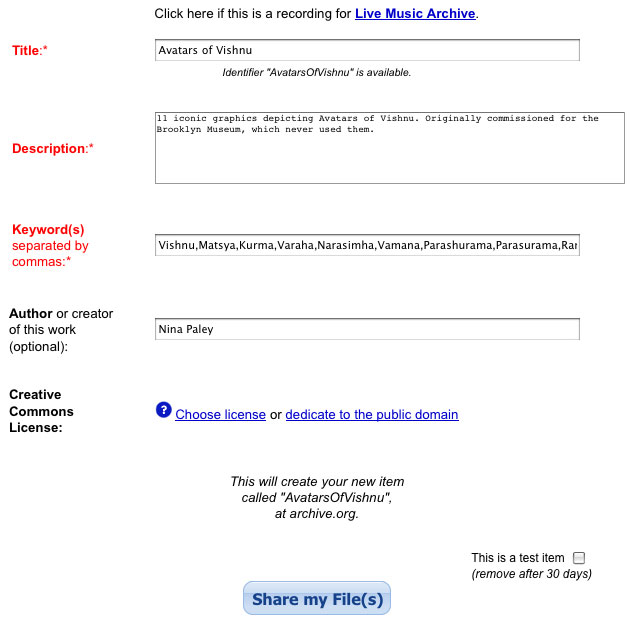
Fill out the fields (unlike this example, you should include a link to your web site in the “description” box!), then click “choose a license.” Archive.org lets you attach both Free and un-Free Creative Commons licenses to uploaded works. It is very important you specify a FREE license during the upload process.
Archive.org does not let you specify licenses by name; instead they give you a dialog box and ask you to check options. To specify a Free License, you must choose either CC-BY-SA, CC-BY, or CC-0.
To specify CC-BY-SA, check the options as follows:
Allow commercial uses of your work? YES
Allow modifications of your work? YES, as long as others share alike
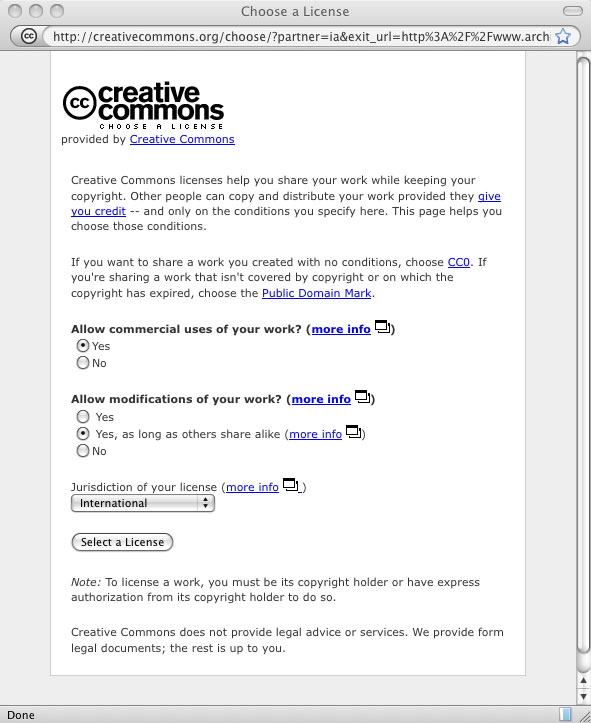
To specify CC-BY, check the options as follows:
Allow commercial uses of your work? YES
Allow modifications of your work? YES
To specify CC-0, click on the CC-0 link.
Once you’ve selected your options, click “Select a License.” You should get a box that looks like this:
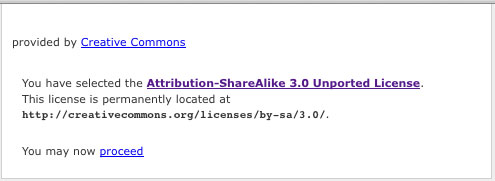
Once the upload is complete, click “Share My File(s)”. Archive.org will create a page for your work that will look something like this:
Copy the URL of your archive.org page, and link to it from your web site and everywhere else. For example, the URL of the page above is http://www.archive.org/details/AvatarsOfVishnu

- Place link to archive.org page on web site. Also write about the work, and post versions directly on web site if possible.
You want your work to be as easy and convenient to copy as possible. A text is likelier to be read if it’s formatted for existing browsers and eReaders. A song is likelier to be used in films, videos, dances and remix projects if it’s available in high quality .wav; it’s likelier to be shared by fans as an .mp3 or .ogg. Images are most easily shared on web sites as low resolution jpegs and .pngs, but they can have far more applications as vector files (.svg, .eps) and high resolution TIFFs. Ideally, release your work in as many formats as possible.
But how do you do that? Reformatting can be a real pain, and how do you even know what file formats your audience wants?
This is where fans come in. Ask your fans for help – even if you only have one fan, or a small handful. Release a master file and ask them to convert to other formats. If you’re a musician, upload an uncompressed .wav file of a song on archive.org. Then ask fans convert it to .mp3, .ogg, and other formats and repost those on archive.org, as well as everywhere else they can share the files.
I released “Avatars of Vishnu” illustrations as high resolution .png files. A fan immediately converted them to .svg vector files.
Once fans know you’re releasing your work under free licenses, they may convert your files to more useable formats as a matter of course. In addition to providing a valuable service, this work strengthens the bond between fan and artist; what Mike Masnick calls “CwF” (“Connect with Fans.”)
- If work is a video, upload it to Youtube and Vimeo in addition to Archive.org. Include links to archive.org page and your own web site in “description” field (see example). Embed the video on your own site.
- PROMOTE. Tell all your fans. Ask them to spread the word. If you have Twitter, Facebook, and other social network accounts, post that your work is up and Freely available. Make sure to name the specific license (ie, CC-BY-SA, not “Creative Commons”), so they KNOW it’s Free. Include link to your web site.
The Internet isn’t for everyone. Not everyone wants to spend time on FaceBook, or Twitter; not everyone “gets” them. Not everyone wants to blog, or email, or whatever the kids are doing these days. One solution is to force yourself to learn how to use these tools, but there is another option: ASK YOUR FANS TO DO IT FOR YOU.
If you’re a musician who gives live concerts, ask for “social media” volunteers at your next performance. If you’re an artist who dislikes the Internet, but goes to openings and parties and networking events in Real Life, put the word out among your friends, fans, and patrons. If you teach, let your students know you’re looking for help. Others can take care of online promotion for you – if you let them. The best way to let them is to give them a stake in your art, and not try to control them. Once again, Freeing your work is the key to receiving this service. Then fans aren’t doing work for you, they’re doing work with you. As long as you place copy restrictions on your work, fans will feel exploited. By Freeing your work, you and your fans are on the same team.
- If you have something to sell in connection with the work (DVDs, CDs, T-shirts, Keychains, services, custom commissions, etc.) make these available when you release the work. If you have an online store, link to it. If you’re a performer, bring items to your performances and have a volunteer sell them for you. Let people know they can purchase said merchandise at your shows.
There are countless ways to make money with Free works. Freeing them is the first step.
My business model is “Content is Free, containers are not. Use the unlimited resource to sell the limited resource.”
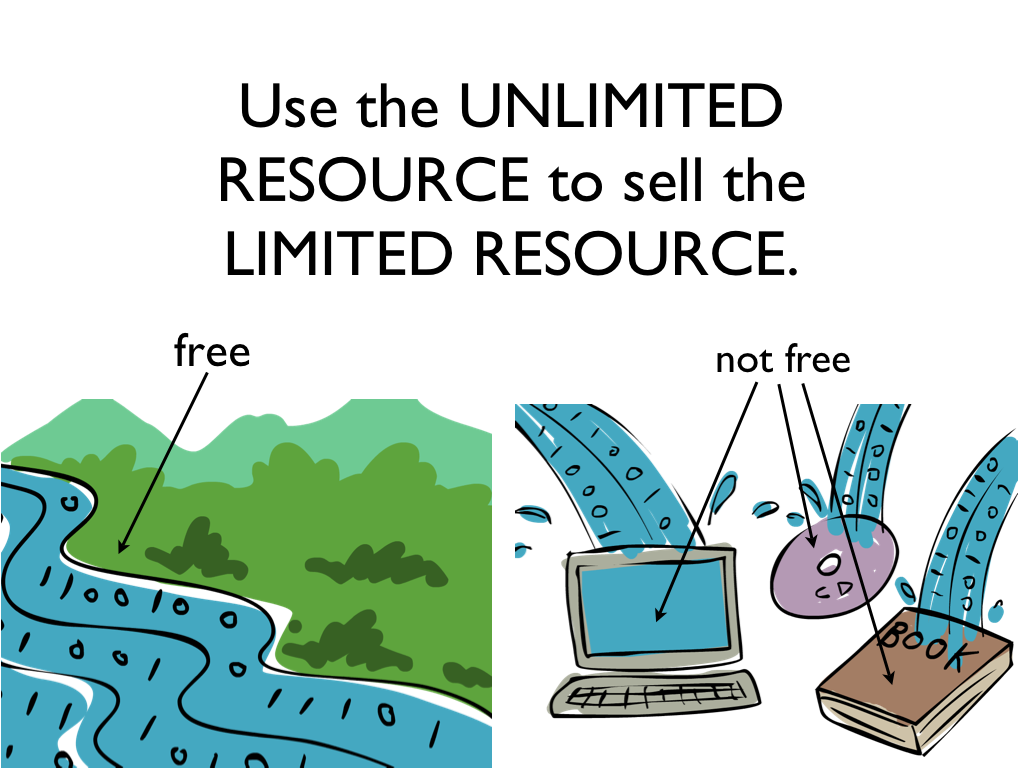
Just because your content is Free, doesn’t mean you can’t sell “containers” of it: paper books, discs, hard drives, prints, paintings, and so on. One successful example of this principle in action is my own “Sita Sings the Blues” e-store. Authors whose ebooks are available for free sell more paper copies (see Paulo Coelho). The more content (which is non-ravalrous) circulates freely, the greater demand for rivalrous goods related to it. Which you or your agents can sell.
Related, but not exactly the same as ours,is Techdirt.com‘s basic business model for artists: CwF+RtB (Connect with Fans + Reason to Buy = $$). You can read numerous ways this principle is making artists money in Techdirt’s Case Studies. Although Free works aren’t a prerequisite for this model, they work perfectly with it.
- Let go. There is no time limit; once your work is Free, it can be discovered and “catch on” at any time. There are no guarantees of success in the arts. You’ve done your part: you’ve removed one large obstacle, by removing copy restrictions. The rest is up the the wider world. Now is a good time to think about your next piece of art!
By putting your work out there. Make the art you want to see, and share it. Be patient. It may take a while. The most important thing you can do at this stage is focus on your art, making the art you want to make, and Freeing it to the best of your ability so that others, sooner or later, can find it and share it with the next potential fan.

Hello Nina,
this article is incredibly fascinating: it made me think a lot about the possibility to distribute with this method a book that I wrote last year. For the moment I decided to use a Creative Commons licence CC BY-NC. I decided to use a non commercial license because my book (freely downloadable from here: http://baglioni.paroledimusica.com/) is an essay about the music of a famous Italian singer called Claudio Baglioni, and in this book I use small samples of the lyrics of the songs as well as small samples of music scores. I use them just for analysis purpose, according to the fair use allowed by law. This is why I used such a non commercial license and I didn’t upload my work to archive.org: I’m scared that I could infringe Baglioni’s copyright allowing other people to use commercially something that I don’t own.
In the same way, I’m wondering if for “Sita sing the blues” is it really possible to allow other people to use it for commercial purposes if it contains old songs protected by copyright. Even if the use for the making of the film was paid, is it really possible to give permission to use those songs commercially to other people? In the same way, do you think that I could use a free license and upload my book to archive.org without any problem? I would be grateful if you could answer to my doubts.
Thank you, and congrats for your great job, as artist and for sharing such useful informations.
Filippo
If it is “fair use” for you to quote the material and release it under a CC-By-NC license, then it is equally so under a By or By-SA license.
As for “Sita Sings the Blues”, the use of non-free content is awkward, but certainly not illegal. Nina Paley could not release Sita this way had she used By-SA content herself — because the By-SA license forbids combination with non-free content.
However, SStB relies on public domain work and original work by Paley and does not use By-SA licensed source material (or where it does, she has specific permission from the author). As such, she is not actually releasing under the By-SA license herself, and thus she can have exceptions like this.
The upstream licensing on the music means that we who receive the work cannot treat the whole work as By-SA. Instead, we have to strip out the non-free content if we want to remix it (except in as much as the reuse would fall under “fair use”). The music is commercially licensed for her to distribute. She does in fact pay royalties on the copies she sells. On those she gives away, however, she doesn’t owe any (they are considered “promotional” copies under the legacy system).
As for your book, you should probably consult a lawyer if you are worried about it. From what you say, it may very well fall under fair use, but jurisdiction matters, and details like how much you quote and for what reason you quote (generally, quoting material in order to review it is fair use in US jurisdictions, for example).